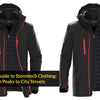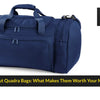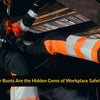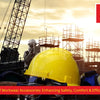Top 8 Reasons Why Safety Helmets Are a Must for Construction Workers
- by Mike Johnson

Safety helmets, often referred to as hard hats, are a fundamental element of personal protective equipment (PPE) that safeguards construction workers from severe injuries that could be inflicted by falling objects, unforeseen accidents, or electrical hazards.
In industries such as construction, mining, and manufacturing, the use of safety helmets is not only critical but also legally mandated in many countries, including the UK.
This article aims to list out the top 8 reasons emphasising the importance of wearing safety helmets at construction sites and why it is a must for safety-conscious construction workers in the UK.
1. Robust Defence Against Head Injuries
One of the most vital pieces of personal protective equipment (PPE) for workers in hazardous environments is the safety helmet. Safety helmets are specially designed to provide strong protection against potential head injuries that may result from falling objects, collisions, or electrical hazards at workplaces.
They are made from robust materials that can resist high amounts of force and avoid severe injuries such as broken skulls, brain contusions, and traumatic brain injuries.
For instance, the PORTWEST ENDURANCE BASIC SAFETY HELMET HARD HAT ECONOMY HELMET- PW50 available at Active Workwear, is designed with a high-density polypropylene shell and an energy-absorbing liner that significantly improves protection from impacts and penetrations.
2. Vital for Workplace Safety
Safety helmets are often mandatory at construction sites and other hazardous workplaces. They help workers avoid potential dangers such as flying debris, electric shocks, and other threats on the site.
By using safety helmets, workers can greatly lower the chance of head injuries, creating a more secure work environment.
3. Protection in High-Risk Industries
In industry sectors such as mining and construction, the risks posed by head injuries are so overwhelming that standard safety helmets might not be sufficient.
In such cases, high-performance industrial safety helmets, like the JSP EVOLite Skyworker Industrial Working At Height Safety Helmet offered by Active Workwear, should be provided to the workers. These helmets meet the EN12492 standard, providing the ultimate protection against impacts.
4. Prevention of Traumatic Brain Injuries
Traumatic brain injuries can impair a person’s mental and physical functions for a long time. By using a safety helmet, people can lower their chance of getting a traumatic brain injury, possibly preventing them from permanent impairments.
5. Compliance with Safety Regulations
Many industries and activities have safety regulations that require the use of safety helmets. These regulations are in place to ensure that individuals are protected from harm while performing their tasks.
For instance, safety helmets like the BEESWIFT RATCHET WHEEL ADJUSTMENT VENTED SAFETY HELMET HARD HAT - BBVSHRH and DELTA PLUS VENITEX ZIRCON SAFETY HELMET HARD HAT-ZIRCON DELTA PLUS available at Active Workwear, comply with the EN397 industrial standard, ensuring maximum safety.
6. Personal Safety
Using a safety helmet is a vital measure in safeguarding one’s personal well-being. Even in scenarios where a helmet is not mandatory, using one can greatly lower the chance of head injury.
7. Sets a Good Example
By always wearing a safety helmet, individuals can set a good example for others and promote a culture of safety in their workplace, school, or community. This can reduce the risk of mishaps and harm, creating a more secure and well-being environment for all.
8. Enhancing Employee Visibility
Wearing safety helmets can also enhance the visibility of employees. This is particularly useful in large construction sites where supervisors may not be familiar with all workers. Differentiated branding on safety helmets for each department helps identify them on a much broader level.
Important Safety Helmet Features
When choosing a safety helmet, the following features should be taken into consideration:
- Shell: The helmet's outer shell should be sturdy and made from a hard material like high-density polyethene (HDPE) or Acrylonitrile Butadiene Styrene (ABS) plastic. The shell provides the first line of protection against impact and penetration.
- Liner: The helmet's liner should provide shock absorption and help distribute the force of an impact over a larger area, reducing the risk of injury.
- Suspension System: The helmet should have a suspension system to hold the shell and liner in place on the wearer’s head. It should include an adjustable strap or harness that can be adapted to fit the wearer’s head snugly.
- Chin Strap: The chin strap ensures to keep the helmet securely on the wearer’s head in the event of an impact. It should be adjustable and made of a strong material like nylon or polyester.
- Ventilation: Many modern safety helmets are designed with ventilation systems to help keep the wearer cool and comfortable. These ventilation systems typically include vents in the shell that allow air to circulate around the head.
- Visibility: Some safety helmets are designed to increase the wearer’s visibility, particularly in low light or dark conditions. These helmets may include reflective strips or other materials that reflect light, making the wearer more visible to others.
- Compatibility: Safety helmets may need to be compatible with other safety gear, such as ear protection, face shields, or respirators. It’s important to ensure that the helmet can accommodate these accessories and still fit securely on the wearer’s head.
- Durability: Safety helmets are designed to withstand multiple impacts and provide long-term protection. A good quality helmet should be durable and able to withstand wear and tear over time.
- Weight: The weight of a safety helmet is an important consideration, particularly for workers who need to wear the helmet for extended periods. A helmet that is too heavy may be uncomfortable to wear and can cause neck and shoulder strain.
- Certification: A safety helmet should be certified to meet specific safety standards set by regulatory bodies in the region where it will be used. It’s important to ensure that the helmet has the appropriate certification for the intended use to ensure maximum protection.
Conclusion
Safety helmets protect workers from head injuries in various industries and situations. Active Workwear provides a range of high-quality safety helmets that not only comply with safety standards but also ensure comfort and ease of use for the workers.
Always remember to use a safety helmet to secure yourself fully, and keep in mind, in severe cases, these injuries may result in lasting disability or even death, bringing irreversible damage and pain to you and your family.
Ensure your safety today by investing in the best safety helmet for construction. Visit our Active Workwear website and explore our wide range of safety helmets that provide maximum protection, comfort, and durability.
Take a step towards a safer work environment now!
Comprehensive FAQs on Safety Helmets for Construction Workers
1. Do safety helmets have to be worn on a construction site?
The risks of receiving a head injury are deemed high enough that the law requires head protection, such as safety helmets, to be worn on almost all construction sites in the UK. All workers must be provided with and wear suitable head protection to comply with the Personal Protective Equipment Regulations 1992. The only exemption is for turban-wearing Sikhs, who are not legally required to wear a safety helmet on a construction site.
2. What is the standard for safety helmets used on UK construction sites?
Safety helmets used on UK construction sites must meet the specifications outlined in the BS EN 397:2012+A1:2012 standard, the British standard of performance and testing requirements for industrial safety helmets. This standard covers aspects such as shock absorption, resistance to penetration, flame resistance, and chin strap anchorage.
3. How often should I replace my safety helmet?
Safety helmets should be replaced at least every five years or sooner if they show any signs of damage, such as cracks, dents, scratches, or fading. The date of manufacture should be marked on the helmet, and the user manual should guide on the recommended replacement period.
4. What additional features can I find on a safety helmet?
Safety helmets may have additional features to enhance comfort, protection, and functionality, such as:
- Ventilation holes to improve air circulation and reduce heat build-up
- Retractable eyewear, face shields, or earmuffs to protect against dust, noise, or flying debris
- Reflective strips or stickers to increase visibility in low-light conditions
- Slots or clips to attach accessories such as lamps, cameras, or radios





